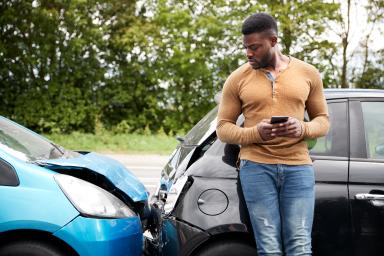Pennsylvania Car Accident Laws

According to the Pennsylvania Department of Transportation (PennDOT), 1,230 people died in car accidents on the state's roads in 2021, the highest number since 2012. Speeding and drunk driving were the leading causes of fatalities, accounting for 441 and 124 deaths, respectively, in 2021. The second most common cause of car accidents is distracted driving, with 12,703 reported collisions. Statistics also show that the counties with the most traffic-related fatalities were Philadelphia, Lancaster, Allegheny, Bucks, York, and Berks.
To protect Pennsylvania vehicle owners, car collision victims, and traffic accident plaintiffs, lawmakers and officials have enacted the following regulations and legislation, as well as minimum insurance requirements and personal injury liability standards.
Pennsylvania Safety Belt Use and Child Passenger Restraint Laws
Seat belts are required for all drivers and passengers in Pennsylvania, regardless of the distance traveled. Those who break the rules may face a fine of $10. Drivers 18 and older who are stopped for another traffic violation will be issued a second ticket if they or their front-seat passengers are not buckled up.
Pennsylvania has joined the national Click It or Ticket campaign in an effort to reduce the number of unrestrained drivers and passengers who are injured or killed in car accidents. The Pennsylvania State Police and over 600 municipal police departments are on the roads in May and November to enforce the law. Authorities continue to raise awareness that seat belt usage increases a car occupant's chances of surviving a crash by up to 60%.
Child Passenger Safety Guide
The state requires car drivers to abide by the primary child passenger safety law to ensure that their infant or child passengers are properly restrained using a car seat, booster seat, seat belt, or LATCH system before traveling. Failure to follow the rule can result in a $75 fine plus court costs, a $10 EMS fund charge, a $45 surcharge, and a $10 administrative cost. Here are the rules for parents who are driving with children:
Car owners can use the NHTSA's Car Seat Finder to find the best car seat for their children. According to the Pennsylvania Department of Transportation crash statistics from 2017 to 2021, 83% of children under the age of 4 who were involved in crashes while restrained in a child seat sustained no injuries.
Pennsylvania Distracted Driving Laws
Experts in traffic safety strongly advise drivers to avoid engaging in any activity that could take their eyes off the road or their hands off the steering wheel. Accidents can happen when a driver is distracted by visual, manual, or cognitive distractions such as texting, eating, grooming, or picking something up from the floor. In 2021, distracted drivers were involved in over 12,700 car accidents in Pennsylvania, 58 of which were fatal.
Texting-While-Driving Ban
State law prohibits drivers from sending, writing, or reading a text or email using a smartphone, personal digital assistant, or mobile computer while the car is moving. Instead, the legislation allows the use of a GPS or any other system embedded in the vehicle.
Distracted drivers must accept responsibility for their actions. The penalty is a summary offense with a $50 fine plus court costs and fees. While the violation results in no points on the driver's record, violators may be imprisoned if the accident results in injury or death. Drivers caught texting and driving may face the following penalties under Daniel's Law: two years behind bars for causing serious bodily harm or a five-year prison sentence for causing a fatality.
It is not illegal for Pennsylvania drivers to use a hands-free or handheld phone while driving. However, legislators have announced plans to have a total ban on phone use while driving, with harsher penalties.
Pennsylvania Basic Speeding Law and Absolute Speed Limits
According to PennDOT's 2021 Pennsylvania Crash Facts & Statistics report, speeding remains a major contributor to deadly crashes. Figures show that 441 of the 25,958 speed-related automobile accidents were fatal. To reduce the number of road crashes due to overspeeding, Pennsylvania has enacted basic speeding laws and absolute speed limits. The state's legislation makes it illegal to drive faster than the following speed limits in designated areas:
Safe Speed Requirement in Pennsylvania
Drivers are not allowed to go faster than is safe and reasonable for the current conditions. Motorists must always drive at a safe speed under the basic speed law. In good weather, for example, 55 miles per hour may be safe. However, if it is raining and the roads are slick, traveling at 55 mph could be hazardous. So, driving at 55 mph in inclement weather is considered a violation of the basic speeding law.
Penalties for Speeding
The fine for most speeding violations in Pennsylvania is $35 plus $2 per mile over the speed limit. If the speed limit is 65 mph or higher, the fine is $42.50 plus $2 for every mile over the limit. Drivers who exceed a school zone's posted speed by more than 11 miles per hour may face a $500 fine. The Pennsylvania Department of Transportation also decided that drivers who exceed the posted speed limit by more than 31 miles per hour could have their license taken away for 15 days or pay a special fine. Additionally, drivers under 18 charged with overspeeding will automatically have their license suspended for 90 days.
Speeding violations result in the following license demerit points:
Drivers who accumulate too many points face penalties, such as license suspension and the completion of a driver improvement course.
If a reckless driving conviction results from a speeding car accident, the violator faces a $200 fine, a 90-day prison sentence, and a six-month license suspension. If a victim dies due to the accident, the driver will be charged with homicide-by-vehicle, a third-degree felony punishable by up to seven years in prison and a maximum fine of $15,000.
Pennsylvania Drunk Driving Laws
The Driving Under the Influence (DUI) Law in Pennsylvania prohibits drivers from driving or operating a vehicle after consuming enough alcohol to render them incapable of driving safely. The legal limit for per se blood alcohol content (BAC) in the state is 0.08%. In Pennsylvania, there are three levels of DUI: general impairment (0.08 to 0.099% BAC), high BAC (0.10 to 0.159% BAC), and the highest BAC (0.16% and higher). As a result of the increasing number of car accidents caused by impaired driving, harsher penalties are in place. Alcohol-related car accident fatalities increased to 311 in 2021, up from 293 in 2020, accounting for 25% of total traffic deaths. In the same year, there were 44,531 DUI arrests and 35,023 drug-impaired driving charges filed.
Zero Tolerance Law for Underage DUI
Drivers under the age of 21 convicted of driving with any amount of alcohol in their blood face serious penalties under Pennsylvania law. A BAC of at least 0.02% within two hours of driving is all that is required for an underage driver to be charged with driving under the influence. According to PennDOT data for 2021, drunk drivers between the ages of 16 and 20 were responsible for 18% of all traffic fatalities.
Penalties for Impaired Driving
General Impairment Penalties
Drivers with a blood alcohol content (BAC) of 0.08% to 0.10% will be subject to the following punishments:
High BAC Penalties
Car drivers with a blood alcohol content of 0.10% to 0.16% face harsher penalties. These consequences also apply to offenders who were under the age of 21 or involved in a crash that caused injury, death, or property damage.
High BAC Penalties
Vehicle operators with a BAC of.16% or higher, controlled substances in their system, or who refuse breathalyzer testing in breach of the government's implied consent law will face the penalties listed in the table below.
Under Pennsylvania's implied consent law, also known as the O'Connell warning, anyone who drives is deemed to have given consent to one or more breathalyzer or blood tests. This rule applies when a driver is lawfully pulled over on suspicion of DUI. If the driver refuses to be tested after the O’Connell warning is read, the arresting officer can seek a search warrant in order to collect a blood sample. If the driver refuses to take the test, the officer will notify the Department of Transportation (DOT), which will then impose a 12-month license suspension.
Pennsylvania Hit-and-Run Law
Drivers in Pennsylvania who are involved in an accident must stop immediately and remain at the scene until law enforcement arrives, especially if they cause personal injury, death, or property damage. They are also advised to move their vehicle off the road so that they do not obstruct traffic and to assist anyone who may have been injured in the car accident. Additionally, they should provide the other party or police officers investigating the accident with identification, vehicle registration, and insurance information.
Penalties for a Hit-and-Run in Pennsylvania
If a driver is accused of leaving the scene of an accident, they may face a hefty fine, probation, a prison sentence, or restitution to the other party. If a driver is convicted of a hit-and-run offense, their driving privileges will be suspended or revoked. The table below lists the violations and the penalties associated with them.
Pennsylvania Minimum Auto Insurance Requirements
It is mandatory for car owners in Pennsylvania to purchase and maintain car insurance or financial responsibility in order to legally drive in the state. The required coverages are:
Here are the optional coverages that car drivers can purchase:
Penalties for Driving Without Insurance in Pennsylvania
There are consequences for failing to maintain liability insurance on a registered vehicle. If a driver is pulled over for a moving violation and PennDOT discovers that they are driving without insurance, they may face the following penalties and expenses:
• A fine of at least $300
• A three-month suspension of vehicle registration
• A three-month suspension of one's driver's license
• Fees for restoring the vehicle registration
• Fees for restoring the driver's license
• Vehicle impoundment
Pennsylvania's Choice No-Fault Car Insurance System
The state of Pennsylvania doesn’t have a no-fault or fault-based system. It allows car owners and drivers to decide whether to purchase fault-based insurance (full tort insurance coverage) or no-fault insurance (limited tort insurance coverage).
Full Tort and Limited Tort Coverage
Full tort coverage allows you to sue for both economic and non-economic damages. Economic damages include medical bills and lost wages. Non-economic damages include pain and suffering.
With full tort coverage, you can seek compensation for economic and non-economic damages suffered as a result of a motor vehicle collision regardless of the severity of your injuries. You may need the help of an experienced car accident attorney to ensure you receive adequate compensation.
Limited tort only allows you to sue for economic damages. These are your medical bills and lost wages. That means, generally, you are unable to seek compensation for pain and suffering unless you meet one of the exceptions to limited tort.
Product Liability: Was the crash or your injury caused by a defective product?
Drunk Driver: Was the crash caused by a drunk driver? If so, the limited tort restrictions do not apply.
Uninsured Driver.
Out-of-State Vehicle.
Passenger in a Commercial Motor Vehicle.
Pedestrian or Cyclists.
Serious Injury.
Modified Comparative Fault Rule for Car Accident Lawsuits in Pennsylvania
The "modified comparative fault" rule is followed in Pennsylvania. This means that the amount of compensation available to a car accident victim is limited by the percentage of fault they bear. Authorities calculate and determine the total percentage of fault that each party carries, as well as the dollar amount of the plaintiff's damages, based on the evidence. For example, if a jury decides that a plaintiff's total damages award should be $100,000, covering hospital bills, lost wages, vehicle damage, and pain and suffering, but the plaintiff is also found to be 30% at fault for the accident, the plaintiff will only receive 70% of the total, or $70,000. If the victim is found to be more than 50% at fault for the collision, they will receive no compensation.
Pennsylvania's Statute of Limitations for Car Accidents
According to Pennsylvania law, victims of car accidents must file a personal injury lawsuit against negligent parties within two years of the accident. A victim's claim will be time-barred if they wait longer than the statute of limitations.
Average Settlement for Pennsylvania Car Accident Lawsuits
Individuals who have been injured in a car accident are entitled to both economic and non-economic compensation. The amount of a settlement depends on a number of factors, including the severity of the injuries sustained and the amount of medical treatment required. If they seek assistance and representation from an experienced car accident lawyer, plaintiffs may receive thousands or millions of dollars in compensation.
Legal Resources for Pennsylvania Car Accident Victims
Pennsylvania Bar Association Pro Bono Program
The Pennsylvania Bar Association offers free legal aid to underprivileged citizens through this service. Individuals who have been in a car accident and need legal advice or assistance should fill out the PBA Pro Bono Program Legal Assistance Request Form. They can also look at the County Pro Bono Map to learn more about volunteer lawyer activities in their area.
Commonwealth of Pennsylvania Driver's Accident Report
If law enforcement did not investigate the crash or if the accident resulted in injury, death, or vehicle damage, drivers must file a Pennsylvania Department of Transportation Driver's Accident Report form within five days of the collision. The report's goal is to collect data that can be used to create accident prevention and reduction initiatives. The website also includes general instructions for completing the form.
Online Crash Report Requests
Car accident victims or their authorized representatives can use the Pennsylvania State Police's Online Crash Report Requests website to locate and acquire digital copies of their crash records. They should wait 15 days from the date of the incident before searching for a report.
Auto Insurance Questions and Answers
The Pennsylvania Insurance Department provides resources to help car owners and drivers understand the state's insurance requirements and the options available to them. They can also access a glossary of the terms that are related to automobile insurance.
Pennsylvania’s Assigned Risk Plan
The Assigned Risk Plan in Pennsylvania is a program that provides automobile insurance to people who can't obtain coverage due to a poor driving record. This program requires the participation of all of the state's insurance providers.
Pennsylvania Driver's Manual
The Pennsylvania Department of Transportation has created a handbook for motorists to guide them on the state's driving laws. The manual also prepares people who want to get a Pennsylvania driver's license to be safe drivers.
Expertise.com StaffAuthor
Step into the world of Expertise.com, your go-to hub for credible insights. We don't take accuracy lightly around here. Our squad of expert reviewers, each a maestro in their field, has given the green light to every single article you'll find. From rigorous fact-checking to meticulous evaluations of service providers, we've got it all covered. So feel free to dive in and explore. The information you'll uncover has been stamped with the seal of approval by our top-notch experts.

Tyler TherriaultReviewer
Tyler J. Therriault is a car accident attorney with Donaghue & Labrum, LLP in Media, Pennsylvania. Locally and nationally recognized, Tyler provides unmatched personal injury representation and support to individuals and families throughout the greater Pennsylvania and all across the country who have suffered injuries or loss as a result of someone else’s negligent, careless, or unlawful actions.

![Airbag Injuries and Average Settlement Amounts [2023]](https://images.ctfassets.net/k00sbju4hbzq/3BBaoZsvlj0NDySlMekb5V/aae10f65f969b6faf29ccfbee387c4d4/Depositphotos_61460709_XL.jpg?fit=fill&w=384&q=75)
![Average Car Accident Settlements [2023]](https://images.ctfassets.net/k00sbju4hbzq/4BBkDDWAQT0dL8I9OSMFnt/36439fec4b6260a58e0c384f64809566/Depositphotos_335949804_XL.jpg?fit=fill&w=384&q=75)
![Can I File a Lawsuit if the Car Accident Was My Fault? [2023] DUP IMAGE](https://images.ctfassets.net/k00sbju4hbzq/KjM0u9gm0nmPN9Agv7fih/5a7d1f7c763eada5c66e5547e6e487e1/Depositphotos_341258876_XL.jpg?fit=fill&w=384&q=75)
